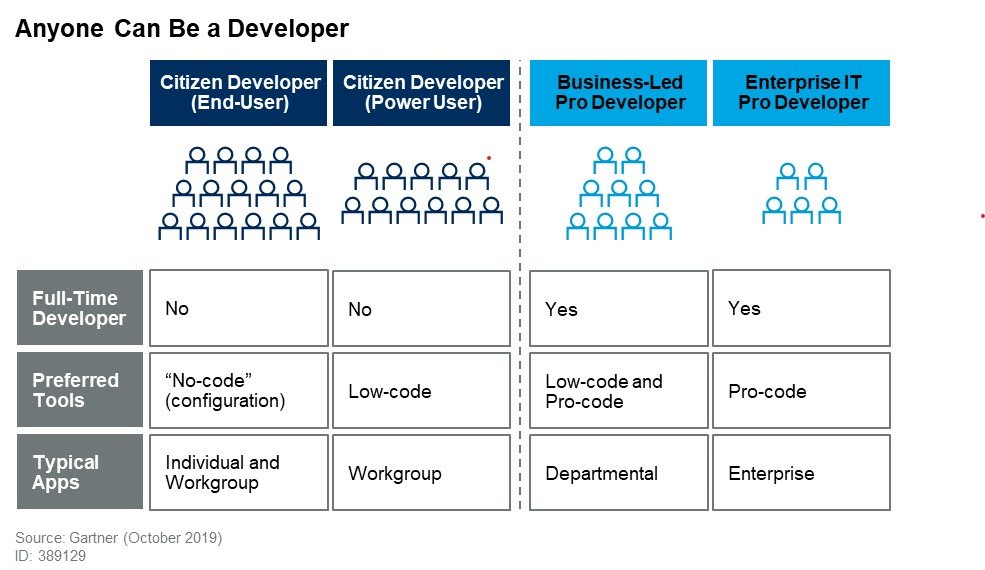Top 7 Reasons Why is Citizen Development the Future of Agile Software Development

According to Gartner, around 70% of business software will soon be deployed using citizen development platforms. Offering a fast, easy, and efficient process to build applications, citizen development is surely the next frontier of agile software development. Here are in-depth insights.
“I am converting this concept into application soon, Eric,” remarked John, a business professional with no IT background. Both John and Eric have worked together for more than decades, have formulated strategies, and steered growth journeys. “Since when have you become a software developer, John?” asked Eric jokingly.
“Well, it’s no fun, pal. We have passed those days when we had to rely on software developers to fructify our ideas into applications,” John noted. “How can you forget the magnificent Excel on which we exhaustively worked for so many years?” John questioned. “True, I even built my own macros without anyone’s assistance!” Eric remembered.
“Yes. We have been citizen developers for so many years, but only that we have now reached a more advanced stage,” goes John further. “Indeed, this is a paradigm shift,” acknowledged Eric.
Like John and Eric, many non-IT business users are realizing the power of citizen development. However, citizen developers have not emerged all of sudden, rather it has been a phased evolution.
In 2012, John K Waters, a Gartner analyst gave a call that “we are all developers now.” The beginning of the new digital era had begun opening up new avenues for non-technical professionals to become developers.
Becoming a subject of speculation, the idea of citizen development became a mainstream concept with the coming of no-code and low-code platforms. With a minimal understanding and knowledge of coding, building applications became a reality. These platforms become a ubiquitous medium to drive citizen development initiatives.
Coming with a bag full of benefits, citizen development has begun enticing large as well as small enterprises alike. In 2020, Microsoft noted that it wanted to build 450 new apps by 2025 using low-code platforms. To implement RPA, Wartsila, the Finnish marine engineering giant, encouraged its staff to become citizen developers, who built more than 400 automated processes.
Trends are giving way to citizen development being the future. The global low-code development industry is forecasted to reach $187 by 2030. And no-code/low-code automation is offering the promise of reducing the application development time by 50%-90%.
As we move ahead, we look at how the all-encompassing character of citizen development can be conducive to enhancing agility in software development.
Let’s Understand the Concepts First: Who Are Citizen Developers and What is Citizen Development?
Gartner has defined citizen developers as “employees who create application capabilities for consumption by themselves or others, using tools that are not actively forbidden by IT or business units. A citizen developer is a persona, not a title or targeted role, and they report to a business unit or function other than IT. All citizen developers are business technologists; however, all business technologists are not necessarily citizen developers.”
So, what we get to see is that citizen developers are all those individual members of an organization who are not software development experts. However, they are experts in different areas of business and are supplemented by no-code or low-code platforms that can build applications that meet their requirements.
This practice of non-IT people engaging in software development is termed citizen development. Remember, citizen development is an approach while no-code and low-code platforms are facilitators in the process.
The Value of Citizen Development
Eric Knipp, who now leads Application Practice in Gartner for Technical Professionals (GTP) noted more than a year ago, in 2009 that
“Future citizen-developed applications will leverage IT investments below the surface, allowing IT to focus on deeper architectural concerns, while end users focus on wiring together services into business processes and workflows. Furthermore, citizen development introduces the opportunity for end users to address projects that IT has never had time to get to—a vast expanse of departmental and situational projects that have lain beneath the surface.”
Businesses require a variety of software applications to achieve rapid digital transformation, support remote working, and streamline automation. But that’s not easily achievable with the available manpower.
Tech teams are finding it challenging to keep up with the growing backlog as demand for digital solutions grows. The cost of programming makes it tougher for firms to justify smaller projects, so they turn to less expensive alternatives (like shadow IT), but these are unstable and can lead to issues in the future.
Utilizing no-code/low-code platforms and assembling a group of citizen developers is a much more successful strategy. This increases the pool of developers and is relatively inexpensive, adaptable, strong, and secure.
The quickest, simplest, and most scalable method for developing, configuring, and managing software is through citizen developers. Because of this, according to Gartner research, by 2024, citizen developers will be using low-code technology to deliver at least 70% of all new business software.
The ability of citizen developers to clear significant amounts of organizational backlogs is one of their main draws. This is significant given that TWO-THIRDS of software projects are routinely behind schedule. Organizations that invest in developing citizen developers give people new skills and career options that keep people interested and motivated.

Where is Citizen Development Making a Difference?
Citizen development has already begun leaving its footprints. The impact can be seen across many areas. The best citizen development initiatives typically include building business process automation applications. They adhere to the principles of routine, repeatable, and rules-based automation. You are seeking straightforward, objective activities that can be completed quickly and easily.
Business users have grown more inclined towards bringing in AI and machine learning capabilities to improvise decision-making. With no-code and low-code machine learning tools, democratizing AI has become far easier for them.
Enterprises can build applications with AI and ML capabilities without coding expertise. Thanks to low-code and no-code platforms with simple drag-and-drop features. These platforms help build machine learning applications while lightening the workload of data scientists. They make it simple to create and train ML models, much as how no-code and low-code development platforms are used to construct software applications quickly with little to no coding.
In general, some areas where citizen developers can prove to be of massive value for organizations are:
- Key functions like HR, Marketing, Supply chain, Finance, the IT help desk, and facilities management can receive support from citizen development programs.
- Citizen developers can create better or more unified user interfaces for current apps or enhance corporate procedures and processes within apps.
- They can streamline workflow automation – end-to-end procedures that link several systems or data sets.
Citizen Development Holds the Key to Building Truly Agile Future Teams
Here are the reasons to convince you that citizen development is the future of agile software development:
Business users on the anvil
No one understands better than the users themselves when it comes to incorporating functionalities in the application. Thus, citizen development increases the likelihood of applications becoming more successful. Business users building their own apps know what essential functionality must be there in the application. The apps become more potent and effective as a result.
Say goodbye to backlogs
Most businesses today are on an app-building spree, as they want an application for almost every process and function. The growing demand for software applications often results in backlogs. Achieving milestones becomes grossly difficult for a single team of experts. By encouraging each functional team member, you can parallelly drive multiple projects, without leaving any scope for backlogs.
Become more resilient than ever
Having a larger pool of software talent to develop specialized apps has become an acute need for addressing ever-changing and fluid business needs. In the wake of this challenge, citizen developers are turning out to be great recourse in imparting tremendous flexibility as they expand the talent pool to build, innovate, and add value. The enormous demand for innovation and fresh apps can be met with the help of a committed group of citizen developers.
Development speeds up
By reducing reliance on a small pool of experienced software developers, citizen developers save time. They continuously streamline the innovation process and reduce the delivery time for the product. Equipped with bespoke no-code or low-code platforms at your disposal, you can build numerous minimum viable products (MVPs) in the time in which you would have been able to build just a single MVP without being assisted by citizen developers. This massive difference between speeds is due to the cycle time that’s remarkably reduced by citizen developers.
Save more, earn more
It can be difficult and expensive to find coding experts, especially for new organizations. Traditionally, businesses hired programmers to assist with the coding and development of business applications. However, the development of a single application required months for building teams of software development experts. Businesses can now use no-code platforms to create applications with the help of their internal non-technical staff members. Employing professionals for the software development process doesn’t come at any additional cost.
No more scampering for resources
As businesses attempt to become completely digitized, demand for technical skills has increased, particularly in the tech industry. Citizen developers can remove delays and quicken the development process with the right training. Business users can be trained by organizations to build applications, thus complementing the existing software development expertise, thereby reducing the burden on the core software development team and helping in dealing with ad-hoc requirements.
Better productivity leads to more agility
Citizen developers boost productivity by enhancing agility. They enable businesses to easily automate processes, which in turn makes it easier for firms to perform more tasks without strain. By enabling staff to use technology in their work, citizen development aids in accommodating changes with ease. So, encouraging a citizen development program can allow businesses to set a culture of agility in the team.
Time to Embrace Citizen Development for Seamless Agility
The breakneck speed at which businesses are adopting technology has created a strong case for the initiation of citizen development programs. In order to practically implement the idea, all you need is a strong citizen developer framework.
No-code/low-code platforms are the bridge that connects your non-technical team members with software development. As a preliminary step, you need to identify the tools that will support requirements and make you future-ready in a full-fledged manner.
The success of citizen development can be aided by having a clear understanding of the governance principles, roles, and responsibilities, notwithstanding the security issues that can be caused by shadow IT.
The success of citizen development lies in making non-technical professionals focus on core software development rather than routine troubleshooting. Connect with us to know more about how you can reap excellent benefits from citizen development.

